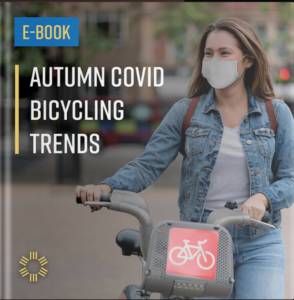- The boom in bicycling in 2020 is providing new and important lessons for transportation planning.
- Planners need more and constant data to adjust to changing needs and to better evaluate and adapt planned bicycling infrastructure.
 One of the major shortcomings in developing and evaluating transportation plans that include bicycling for our region is the lack of data. The StreetsBlogUSA website recently brought to our attention the work of a company, Streetlight Data, that uses smartphones as sensors to measure activity by bicyclists and pedestrians. The findings of their recent study of bicycling trends reveal some positive trends and lessons.
One of the major shortcomings in developing and evaluating transportation plans that include bicycling for our region is the lack of data. The StreetsBlogUSA website recently brought to our attention the work of a company, Streetlight Data, that uses smartphones as sensors to measure activity by bicyclists and pedestrians. The findings of their recent study of bicycling trends reveal some positive trends and lessons.
- American bicycling trips skyrocketed 26 percent at the height of the COVID-19 bicycling boom.
- 88 of the 100 largest US metro areas experienced year-over-year increases in cycling that peaked in June before tapering off throughout the summer as cars returned to the road.
- The surge was much larger in small metro areas than in big cities.
- Riding was still up by 11 percent over the previous year by September. At the same time driving rates stayed down 6.5 percent. Some experts think the change can’t be explained by an increase in recreational riding alone, suggesting instead a major shift in commuters’ and others’ transportation choices.
Across all the cities studied, Streetlight overlaid census demographics to understand which racial, economic, and other demographic groups were best represented and consistently found that biking was up across the board. They discovered that the groups who rode most were not historically what planners have tended to assume. Rather than suburban white people at a higher income level riding for recreation, the increase in ridership crossed demographic lines. The study underlined the importance of planners “prioritizing the needs of those who face the highest barriers to biking, like BIPOC (black, indigenous, and people of color), the low-income, the elderly, and children—and that doing so starts with watching the data closely, especially in volatile times like these.” Streetlight Data also emphasized that planners should not make assumptions about who does or doesn’t ride bikes based on last month’s or last year’s data.
FABB has long encouraged government to give more consideration to developing reliable data and metrics for transportation planning that involves bicycling infrastructure. As this year’s bicycling boom has demonstrated, government needs the capacity to measure—and evaluate—constantly the needs of bicyclists, pedestrians, and other vulnerable road users. As much progress as is being made in adding bicycling infrastructure, Fairfax County still lacks the means to evaluate the before-and-after effectiveness of projects. Other critical data to improve transportation planning includes measuring post-project vehicle traffic and speeds, bike traffic, pedestrian traffic, and crashes by all modes along with economic and community vitality after the installation of bicycling and pedestrian infrastructure. This will require the addition of resources to these data gathering means but it is a worthwhile investment to avoid squandering increased public interest in bicycling to improve transportation options for everyone.
FABB will continue to make data gathering a major part of our advocacy. Want to join in this effort to make bicycling better? Contact us at [email protected].
